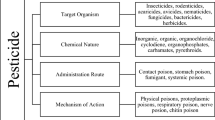Abstract
Bacillus cereus strain PU, isolated from soil contaminated with explosive waste, tolerated up to 1.3 mM 2,4,6 trinitrophenol (TNP) and utilize it aerobically as sole nitrogen and carbon source. Degradation of TNP was accompanied by stoichiometric release of 2.1 ± 0.15 mol nitrite/mol TNP at 539 μmol/h g dry cell wt. Metabolism of TNP was accompanied by transient accumulation of an orange-red metabolite, hydride meisenheimer complex (H-TNP), indicating a metabolic pathway involving complete reductive removal of the nitro group as nitrite.




Similar content being viewed by others
References
Aneja KR (2003) Experiments in microbiology. Plant pathology and biotechnology, New Age International Publishers, New Delhi
Behrend C, Heesche–Wagner K (1999) Formation of hydride meisenheimer complexes of picric acid (2,4,6-trinitrophenol) and 2,4-dinitrophenol during mineralization of picric acid by Nocardioides sp. strain CB 22–2. Appl Environ Microbiol 65:1372–1377
Heiss G, Knackmuss HJ (2002) Bioelimination of trinitroaromatic compounds: immobilization versus mineralization. Curr Opin Microbiol 5:282–287
Hofmann KW, Knackmuss HJ, Heiss G (2004) Nitrite elimination and hydrolytic ring cleavage in 2,4,6-trinitrophenol (picric-acid) degradation. Appl Environ Microbiol 70:2854–2860
Lenke H, Knackmuss HJ (1992) Initial hydrogenation during catabolism of picric acid by Rhodococcus erythropolis HL 24-2. Appl Environ Microbiol 58(9):2933–2937
Nipper M, Qian Y, Carr RS, Miller K (2004) Degradation of picric acid and 2,6-DNP in marine sediments and waters: the role of microbial activity and ultra-violet exposure. Chemosphere 56:519–530
Rajan J, Valli K, Perkins RE, Sariaslani FS, Barns SM, Reysenbach AL, Rehm S, Ehringer M, Pace NR (1996) Mineralization of 2,4,6-trinitrophenol (picric acid): characterization and phylogenetic identification of microbial strains. J Indus Microbiol Biotechnol 16(5):319–324
Reasoner DJ, Geldreich EE (1985) A new medium for the enumeration and subculture of bacteria from potable water. Appl Environ Microbiol 49:1–7
Rieger PG, Sinnwell V, Preuss A, Francke W, Knackmuss HJ (1999) Hydride Meisenheimer complex formation and protonation as key reactions of 2,4,6-trinitrophenol biodegradation by Rhodococcus erythropolis. J Bacteriol 181:1189–1195
Rieger PG, Meier HM, Gerle M, Vogt U, Groth T, Knackmuss HJ (2002) Xenobiotics in the environment: present and future strategies to obviate the problem of biological persistence. J Biotech 94:101–123
Shen J, Zhang J, Zuo Y, Wang L, Sun X, Li J, Han W, He R (2009) Biodegradation of 2,4,6-trinitrophenol by Rhodococcus sp. isolated from a picric acid-contaminated soil. J Hazard Mat 163:1199–1206
Spain J (2000) Introduction. In biodegradation of nitroaromatic compounds and explosives. Spain JC, Hughes JB, Knackmuss HJ (eds) CRC Press, Boca Raton, pp 1–5
Acknowledgment
The authors would like to thank Mr. Ashwini Kumar, Department of Chemistry, Punjabi University, Patiala, India, for his valuable help and technical support during HPLC analysis.
Author information
Authors and Affiliations
Corresponding author
Electronic supplementary material
Below is the link to the electronic supplementary material.
Rights and permissions
About this article
Cite this article
Singh, B., Kaur, J. & Singh, K. 2,4,6-Trinitrophenol degradation by Bacillus cereus isolated from a firing range. Biotechnol Lett 33, 2411–2415 (2011). https://doi.org/10.1007/s10529-011-0726-1
Received:
Accepted:
Published:
Issue Date:
DOI: https://doi.org/10.1007/s10529-011-0726-1




